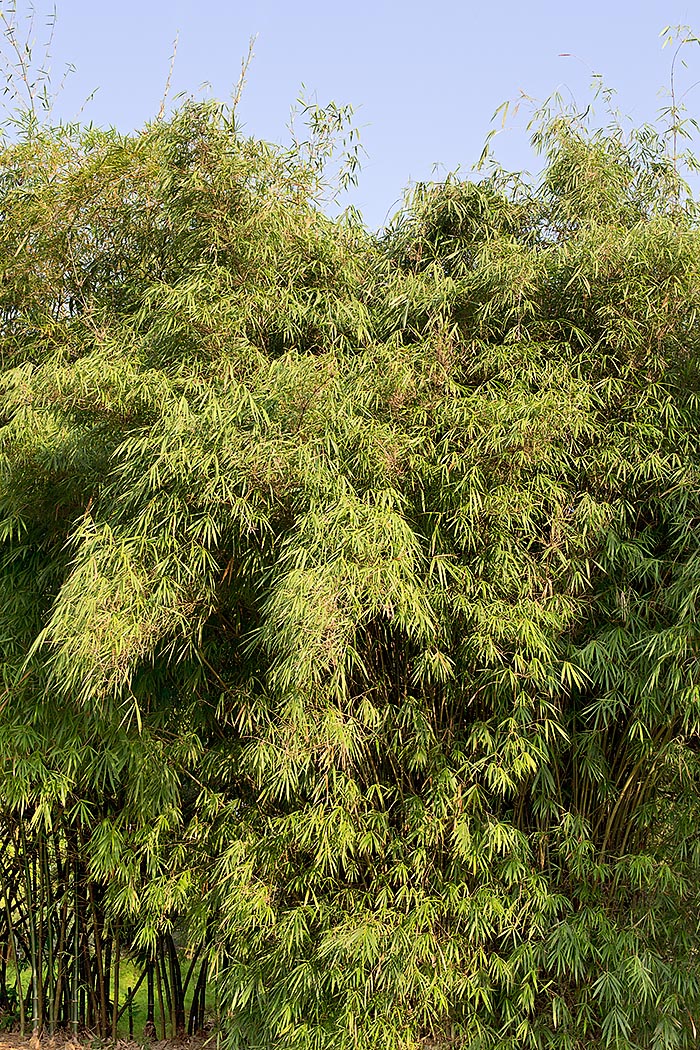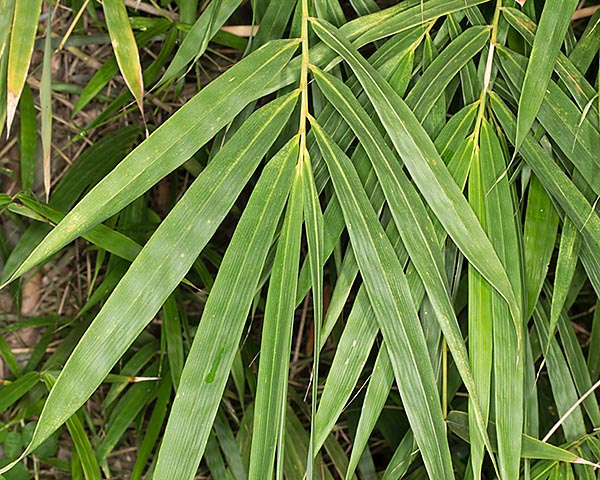Family : Poaceae

Text © Pietro Puccio

English translation by Mario Beltramini

Bambusa heterostachya can be 15 m tall with 3-5 cm stems but dwarf forms also exist © Giuseppe Mazza
The name of the genus comes from the local Malaysian name “bambu”; the name of the species is the combination of the Greek terms “héteros” = different and “stachys” = spike.
Common names: bamboo Malay dwarf (Englis); buluh galah, buluh pengahit, buluh pering, buluh telang (Malaysian).
The Bambusa heterostachya (Munro) Holttum (1946) is an evergreen rhizomatous species with cylindrical close together stems (culms), 6-15 m tall and of 3-5 cm of diameter, erect initially then curved at the apex, hollow between the nodes, with 0,8-1 cm thick walls, and 20-60 cm long internodes of green colour at times with stripes paler or white at the base.
The nodes are slightly prominent.
When young, the culms are protected by deciduous, 13 cm long, bracts covered by brown or black bristly hairs.
Ramifications at the nodes, but in the lower part for about ¼ of the height, with alternate leaves, lanceolate with pointed apex, 15-35 cm long and 2-3,5 cm broad, of pale green colour, glabrous.
Terminal, panicle inflorescences with 10-15 cm internodes and 1-3 spikelets grouped at the nodes, 2-4 cm long and 0,8-1 cm broad, compressed laterally. It blooms regularly.
The fruit is a cylindrical caryopsis (dried indehiscent fruit typical of the Poaceae) of 5-6 mm of length.
It reproduces by seed, stem cutting, but usually and easily by division of rhizomes. Fast-growing species cultivable in the tropical and humid subtropical climate zones and marginally in the warm-temperate ones, where it can stand drops of temperature, exceptional and for short period, up to about -2 °C.

The even 35 cm long leaves are alternate and lanceolate. Fast growth in tropics © Giuseppe Mazza
It is much cultivated in south-eastern Asia.
It can be used for realizing poles, frames, sticks, baskets and other objects of common use and for stabilizing the soil; furthermore, it has very good characteristics as biofuel due to the high calorific power and low contents of humidity and of ashes.
Rather dwarf and variegated varieties have been selected.
Easily to be shaped, by means of appropriate prunings, they form thick tufts, and have become, in few years, very popular in the gardens.
They are used as isolated tufts or for borders, edges and barriers even windbreakers, and are suitable, thanks to the rather contained dimensions, also to small gardens.
Synonyms: Bambusa diversistachya Munro (1868); Gigantochloa heterostachya Munro (1868); Gigantochloa latispiculata Gamble (1896); Bambusa latispiculata (Gamble) Holttum (1946).
→ To appreciate the biodiversity within the POACEAE family please click here.
